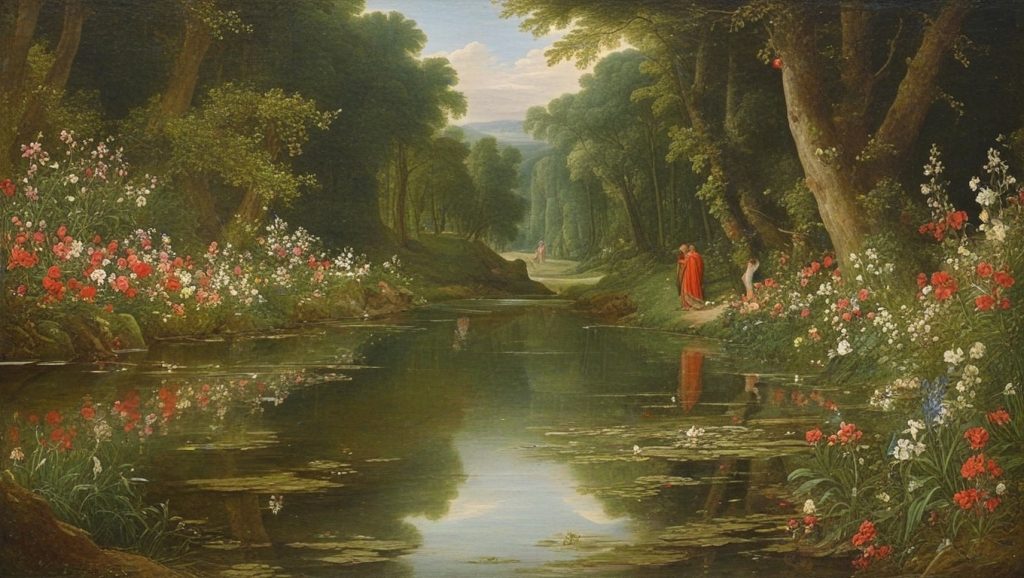
The revelations of Eden deepen as the Pilgrim looks beyond the Seven Lights.
After the Divine Light intensifies above the seven candle sticks, a new cascade of insights are happening for the Pilgrim. First, Virgil admits with his facial expression that he does not understand at all what is happening at this point. And then Matelda, still as the transformed earthly life, pushes the Pilgrim to look deeper, behind, “di retro” of the appearing living lights – suggesting a deeper perception of the spiritual vision is now possible.
And as the Pilgrim looks deeper, he starts seeing people led by these shining lights, which are symbols of the seven gifts of the Holy Spirit: Wisdom, Understanding, Counsel, Fortitude, Knowledge, Piety, and Reverence/Awe of the Divine.
But then Dante writes an extraordinary tercet that transforms Eden from a unified experience of Heaven and Earth, to also being a portal and a transition into the realm of pure spirit.
The tercet is this:
L’acqua imprendea dal sinistro fianco,
e rendea me la mia sinistra costa,
s’io riguardava in lei, come specchio anco.
One way to read this is:
The water took/grasped from the left side,
and rendered to me my left coast/boundary,
if I looked into it, like a mirror again.
Meaning: The spiritual wisdom and vision and insight comes to the Pilgrim on his “left side”, meaning the earthly perception, as the idea of the Heavenly shining through into the Earthly here in Eden.
Then what happens is that these new and stronger spiritual visions are making it more clear for the pilgrim where the boundaries and flows between the earthly and spiritual are; in a way he discovers more clearly the bank/threshold of the earthly perception through which at the moment the spiritual is coming to him. But this boundary is only rendered to him when he looks into the spiritual vision itself, and thus noticing the difference, and the combination of two different realms, reinforcing the idea of “dual perception” being a key capacity that has been trained and developed on the seven terraces. He can now keep both dimensions simultaneously in his mind and experience them at the same time.
And then comes an even deeper point; this apprehension of the spiritual and earthly and the flow/boundaries is like a mirror, meaning it reflects the nature of ultimate reality and the Divine itself: this new perception is in itself an alignment and reflection of being, not merely the nature of his experience. Or in other words: this discovery of the “costa” internally is a revelation of ultimate reality itself, at a cosmic scale. His new capacity for perception is aligned with how reality actually works – thus giving him at times exponentially greater ability to understand this fuller reality.
And as an extra poetic layer of beauty implicitly; The water is also reflecting the Pilgrim himself literally, adding a meta-reflection of the “self” seeing its own role in perceiving, contemplating and participating in this unified experience of reality.
In short: the Pilgrim understands both himself and the big picture in a much deeper way, and detects the shores where the purely spiritual realms begin. This will prove to be essential for his impending final ascent, into the Heavens.

Grace upon grace. The experience of which Beatrice speaks of in Par. 10.52-54 is in full swing:
And Beatrice began, “Give thanks, give thanks
to the Sun of angels Who to this sphere
of perceiving has raised you by His grace.”
❤️🔥😇
Yes, wow! It really begins here – fully widening the capacity for experience, raising and elevating the Pilgrim and us as readers!
And with these “shocks” that realizing that this “other dimension” is simply infinite. No wonder Virgil is just looking at it, confused and in “stupor”!